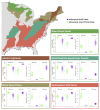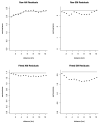Alternative stable states of the forest mycobiome are maintained through positive feedbacks
- PMID: 35210576
- PMCID: PMC7612595
- DOI: 10.1038/s41559-022-01663-9
Alternative stable states of the forest mycobiome are maintained through positive feedbacks
Abstract
Most trees on Earth form a symbiosis with either arbuscular mycorrhizal or ectomycorrhizal fungi. By forming common mycorrhizal networks, actively modifying the soil environment and other ecological mechanisms, these contrasting symbioses may generate positive feedbacks that favour their own mycorrhizal strategy (that is, the con-mycorrhizal strategy) at the expense of the alternative strategy. Positive con-mycorrhizal feedbacks set the stage for alternative stable states of forests and their fungi, where the presence of different forest mycorrhizal strategies is determined not only by external environmental conditions but also mycorrhiza-mediated feedbacks embedded within the forest ecosystem. Here, we test this hypothesis using thousands of US forest inventory sites to show that arbuscular and ectomycorrhizal tree recruitment and survival exhibit positive con-mycorrhizal density dependence. Data-driven simulations show that these positive feedbacks are sufficient in magnitude to generate and maintain alternative stable states of the forest mycobiome. Given the links between forest mycorrhizal strategy and carbon sequestration potential, the presence of mycorrhizal-mediated alternative stable states affects how we forecast forest composition, carbon sequestration and terrestrial climate feedbacks.
© 2022. The Author(s), under exclusive licence to Springer Nature Limited.
Conflict of interest statement
Figures












References
-
- van der Heijden MGA, Martin FM, Selosse M-A, Sanders IR. Mycorrhizal ecology and evolution: the past, the present, and the future. New Phytologist. 2015;205:1406–1423. - PubMed
-
- McGuire KL. Common ectomycorrhizal networks may maintain monodominance in a tropical rain forest. Ecology. 2007;88:567–574. - PubMed
-
- Selosse M-A, Richard F, He X, Simard SW. Mycorrhizal networks: des liaisons dangereuses? Trends in Ecology & Evolution. 2006;21:621–628. - PubMed
-
- Simard SW, et al. Net transfer of carbon between ectomycorrhizal tree species in the field. Nature. 1997;388:579–582.
-
- Klein T, Siegwolf RTW, Korner C. Belowground carbon trade among tall trees in a temperate forest. Science. 2016;352:342–344. - PubMed
Publication types
MeSH terms
Grants and funding
LinkOut - more resources
Full Text Sources

